Accepted Scientific Name: Orbea pulchella (Masson) L.C.Leach
Kirkia 10(1): 290 1975

Stapelia pulchella (Orbea pulchella) Photo by: Luiza Ferreira
Origin and Habitat: Orbea pulchellaSN|30324]]SN|30324]] has a very limited distribution, only being found in the coast regions around Port Elizabeth, Eastern Cape, South Africa.
Altitude range: 20-400 metres above sea level.
Habitat and ecology: Sand-dunes along the coast, sand flats and bank of the Zwartkops River.
Synonyms:
Common Names include:
AFRIKAANS (Afrikaans): Bokhoring Aasblom
Description: Orbea pulchellaSN|19768]]SN|30324]] is an attractive mat-forming, perennial, leafless succulent with short grey, knobbly, 4-angled stems with sulphur-yellow flowers covered with numerous purple-brown dots and specks, smell offensive, attracting carrion flies which thus act as pollinating agents. It is distinguished by its 2-horned inner corona-lobes and small solid annulus completely connects the groups to which Orbea verrucosaSN|19768]]SN|30532]] and Orbea variegataSN|30532]]SN|19768]] respectively belong.
Stems: Like those of Orbea variegataSN|30324]]SN|19768]], 5-10 cm high, erect or decumbent at the base, 8-12 mm thick, obtusely 4-angled, with stout conical acute spreading tubercles, glabrous, green.
Flowers: usually 3 or more together, successively developed near the base of the stems. Pedicels 2.5-3 cm long, glabrous. Sepals 3-6 mm long, ovate to lanceolate, acute or acuminate, glabrous. Corolla 3-6 cm in diameter, smooth on the back, minutely tuberculate-rugulose and glabrous on the inner face, not ciliate, sulphur-yellow, covered with numerous purple-brown dots and specks, which are smaller and more crowded upon the annulus, and the lobes sometimes narrowly edged with purple-brown; disk shallowly saucer-shaped, with a solid more or less pentagonal annulus 8-14 mm in diameter, raised 0.5-1.5 mm above the surface, and a pentagonal pale purplish area margined with brighter purple-red or occasionally entirely sulphur-yellow at the bottom of its cup. Corolla lobes 10-26 mm long, 10-16 mm broad, ovate or deltoid-ovate, very acute or acuminate, very spreading or recurved; outer corona-lobes 2-3 mm long, 1 mm broad, linear or oblong-linear, obtuse, truncate, emarginate or minutely 3-toothed at the apex, dark purple-brown with a pale yellowish spot or somewhat Λ shaped mark below the apex and sometimes along the margins; inner corona-lobes unequally 2-horned, pale yellow spotted with dark purple-brown, or purple-brown with yellow markings; outer horns ascending, 0.5-1 mm long, conical or conical-subulate, obtuse; inner horns 0.5-2.5 mm long, connivent-erect or with recurving tips, filiform, varying from distinctly clavate to not at all thickened at the apex. Pollinia 0.6 x 0.5 mm D-shaped.
Blooming season: Summer-autumn (January to October in habitat).
Fruits: A pair of follicles.
Bibliography: Major references and further lectures
1) N. E. Brown. “Flora Capensis” Vol 4, page 518, 1909
2) Victor, J.E. & Dold, A.P. 2007. Orbea pulchella (Masson) L.C.Leach. National Assessment: Red List of South African Plants version 2014.1. Accessed on 2015/01/23
3) Focke Albers, Ulrich Meve “Illustrated Handbook of Succulent Plants: Asclepiadaceae: Asclepiadaceae” Volume 4 Springer Science & Business Media, 2002
4) Doreen Court “Succulent Flora of Southern Africa” CRC Press, 01 June 2000
5) Noel Urton “Plants of the Swartkops valley bushveld” Zwartkops Trust, 1993
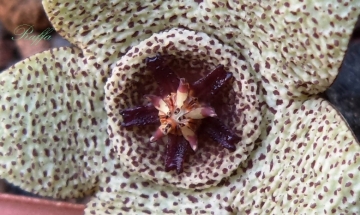 Stapelia pulchella (Orbea pulchella) Photo by: Raffa C. Garcia
Stapelia pulchella (Orbea pulchella) Photo by: Raffa C. Garcia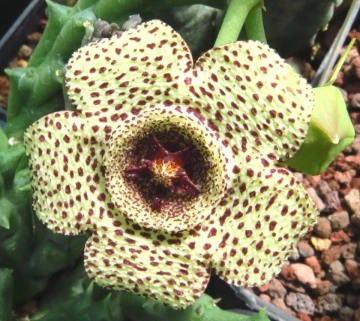 Stapelia pulchella (Orbea pulchella) Photo by: Giuseppe Distefano
Stapelia pulchella (Orbea pulchella) Photo by: Giuseppe Distefano Stapelia pulchella (Orbea pulchella) Photo by: Luiza Ferreira
Stapelia pulchella (Orbea pulchella) Photo by: Luiza Ferreira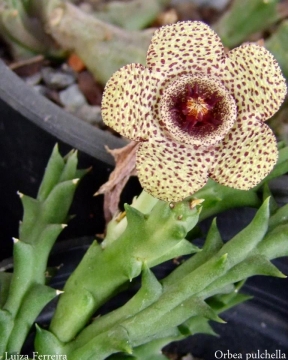 Stapelia pulchella (Orbea pulchella) Photo by: Luiza Ferreira
Stapelia pulchella (Orbea pulchella) Photo by: Luiza Ferreira Stapelia pulchella (Orbea pulchella) Photo by: Luiza Ferreira
Stapelia pulchella (Orbea pulchella) Photo by: Luiza Ferreira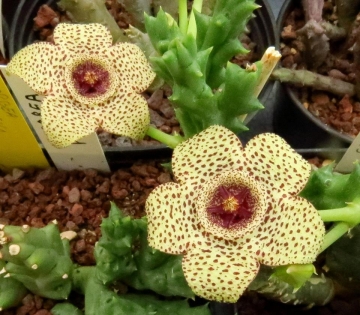 Stapelia pulchella (Orbea pulchella) Photo by: Giuseppe Distefano
Stapelia pulchella (Orbea pulchella) Photo by: Giuseppe Distefano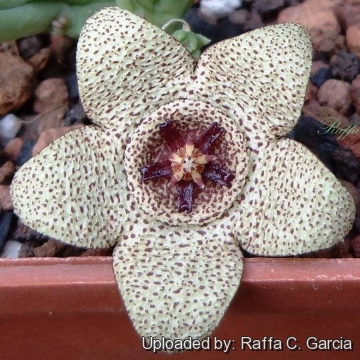 Stapelia pulchella (Orbea pulchella) Photo by: Raffa C. Garcia
Stapelia pulchella (Orbea pulchella) Photo by: Raffa C. Garcia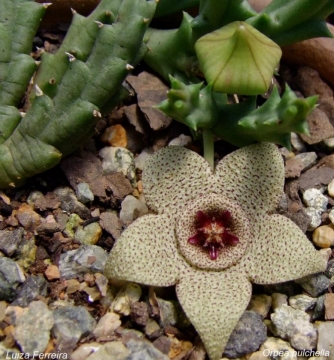 Stapelia pulchella (Orbea pulchella) Photo by: Luiza Ferreira
Stapelia pulchella (Orbea pulchella) Photo by: Luiza FerreiraCultivation and Propagation: Orbea pulchellaSN|30324]]SN|30324]] grow well in light gritty soil with a very liberal drainage. They should at all times sparingly watered (best rain water with some occasional fertiliser), and in winter time they hardly require any. They require outdoor culture, or a warm close greenhouse, while growing in the early part of summer, and afterwards may be ripened and kept in a greenhouse; but as they bloom chiefly in autumn, warmth is desirable to enable them to expand their flowers.
Temperature requirements: A minimum winter temperature of 5-10°C is acceptable (USDA: 9b-11), providing that plants are kept absolutely dry.
Exposure: They prefer light shade rather than full sun, although stems may not colour up under shady conditions.
Pest & diseases: Keep their roots free of mealy bugs, as fungal attack often occurs as a result of damage to stems by insects. A layer of grit on the surface of the compost prevents moisture from accumulating around the base of the stems and minimise the chance of fungal attack on the roots.
Propagation: Plants are usually increased by cuttings, which, as they are very succulent, should be allowed to dry a week after they are taken off, when they may at once be put singly into pots.



















